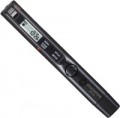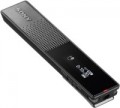Built-in memory
The capacity of the voice recorder's own storage. The
larger the built-in memory, the more material can be recorded on the recorder without the need to free up memory or use additional cards. This parameter is also important if you want to use the device also as a portable flash drive (many modern models allow this).
Max. recording quality (MP3)
The higher the amount of data per unit of time that is used to transmit the audio stream, the higher
the quality of the MP3 recording is provided. So, the base bitrate of 32 Kbps means encoding one second of sound using 32 thousand bits of information - it is used only for speech transmission. Much more common in portable audio recording devices is the recording quality of 128 Kbps, 192 Kbps and 256 Kbps. The maximum possible bits rate for the MP3 format is 320 Kbps. The pursuit of the highest quality of sound recording makes sense for advanced models of recorders; for a conditional voice recorder for recording lectures, the basic bitrate parameters will be quite enough. Also keep in mind that the quality of sound recording affects the size of the resulting files and the duration of the voice recorder.
Max. recording quality (WAV)
Uncompressed WAV provides the best sound quality among common Hi-Res audio formats. Its sampling rate is usually 96 or 192 kHz with a bit depth of 24 bits. The format is used for "clean" sound recording with maximum detail of the scene.
Maximum recording time
The maximum continuous recording time for the voice recorder. It depends primarily on the amount of memory (see "Built-in memory", "Memory card slot"), it is also directly related to the recording quality: the higher the quality, the more space the material occupies and the shorter the maximum recording time. In this regard, manufacturers usually indicate in the specifications the maximum possible recording time, that is, the recording time with minimum quality; with higher quality and time will be less.
Maximum number of folders
The maximum number of folders that can be created in the recorder's memory to store recorded materials. This allows you to organize the materials and makes it easier to find the right record: for example, in journalistic work, the material on each individual topic can be stored in the appropriate folder. Many voice recorders allow you to change the folder used for recording on the fly, literally at the touch of a button.
Frequency range
The range of sound frequencies that the recorder is capable of perceiving and recording. A person is able to hear sound on average from 16 Hz to 20 kHz, but the range of the actual human voice is much narrower — approximately 100-3500 Hz. Therefore, if you plan to use a voice recorder to record speech, these frequencies will be enough. If the purpose of the recorder is not limited to this, you should pay attention to models with a wider range — and in this case, the wider it is, the fuller and richer the recording will be.
Features
—
Change microphone sensitivity. The ability to change the sensitivity of the microphone allows you to optimally adjust it to the surrounding conditions. So, with a low level of extraneous noise (for example, at a lecture or a press conference), sensitivity can be set to the maximum in order to guarantee that everything that is needed is recorded, and in a noisy environment (for example, an interview in a cafe), on the contrary, it can be reduced in order to reduce outsiders noise to a minimum.
—
Change the quality of the recording. Possibility to change the recording quality (usually the bitrate of recorded materials). The volume of the file is directly related to the quality: the higher the quality, the more space the recording takes up. Thus, this function allows you to achieve the optimal balance between sound and memory occupied: for example, for loud intelligible speech without extraneous noise, you can use low quality, in a noisy environment, on the contrary, increase it in order to achieve maximum intelligibility; if there is not much memory left, and nothing can be deleted, lower the quality of the recording, etc.
—
Voice activated recording. When using this function, the recorder only records when its microphone captures a significant level of sound — in principle, this can be any source, but since human speech is most often recorded, the name of t
...his function refers specifically to the voice. With such a recording, the recorder does not record long pauses, which saves both the occupied memory and time (and sometimes nerves) when listening to the recording. The disadvantage of this feature is that activation takes some time and the first sounds may not be recorded on the recording.
— Setting record labels. Ability to assign a unique label to each file. This can be either a number or a time and date, or both. Tags organize entries and make them easier to access, making it much easier to find the right file.
— Recording timer. The timer allows you to set the start time of the recording; when it occurs, the recorder will turn on automatically. Thus, you will be able to record the material you need (for example, a speech or a lecture) from the very beginning, even if you will not be there by the time you start.
— Ring record. The name of this function comes from its resemblance to recording on a magnetic tape closed in a ring. In this mode, the recorder can record regardless of the amount of free memory: new materials are simply recorded instead of the oldest ones. This eliminates the need to clear memory manually and can come in handy if your records quickly become out of date — for example, if you have to take surveys by phone and process the results on the same day. At the same time, this function requires caution, as increases the likelihood of accidentally erasing necessary, but old records.Power source
— Li-Ion
battery(lithium-ion). The most common type of battery for portable electronics today. Such batteries have good capacity, are not subject to the memory effect (reduction in capacity when charging an under-discharged battery) and are easy to use, because are equipped with their own control circuits. From the point of view of the average consumer, they have practically no disadvantages, because They are associated with specialized maintenance and long-term storage. The fundamental disadvantage of any built-in battery is the impossibility of quick replacement; The only option is to charge the battery, which sometimes takes a significant amount of time.
— Li-Pol
battery(lithium polymer). In fact, they are a modified version of lithium-ion batteries (see above). They have the same advantages, in addition, they are more compact (from 1 mm in thickness), which allows them to be used in miniature models. At the same time, lithium polymer batteries do not perform well in the cold.
— AA
battery(or several batteries). Powered by a regular AA battery(s), commonly known as “finger-type” batteries. The advantage of such power supply is the ability to quickly replace a “dead” battery: if you have a spare one, this operation is performed in a few seconds, and buying additional batteries in reserve is usually not a problem - they are sold everywhere. The main disadvantag
...e is the need for financial expenses to purchase batteries, while high-capacity ones are expensive, and cheap ones quickly run out. On the other hand, there are rechargeable batteries in the form of AA batteries; If the voice recorder is used frequently and a lot, the purchase of such batteries may well pay off.
— AAA battery (or several batteries). Powered by a battery or AAA batteries, commonly called “pinky”. They are smaller in size than “finger” AA (see above), making them better suited for portable equipment, incl. voice recorders, otherwise completely similar.
— Coin-cell battery. Powered by a replaceable compact battery shaped like a tablet or button. Such batteries are the smallest option available today, which makes it easier to create compact devices for them. In general, they are similar to AA and AAA (see above), but they have a number of differences, except for the actual form. In particular, there is no single standard for “button” batteries - there are a great variety of them, in different sizes and voltages, which can cause difficulties when finding a replacement for a “dead” battery. In addition, they are much less common.
